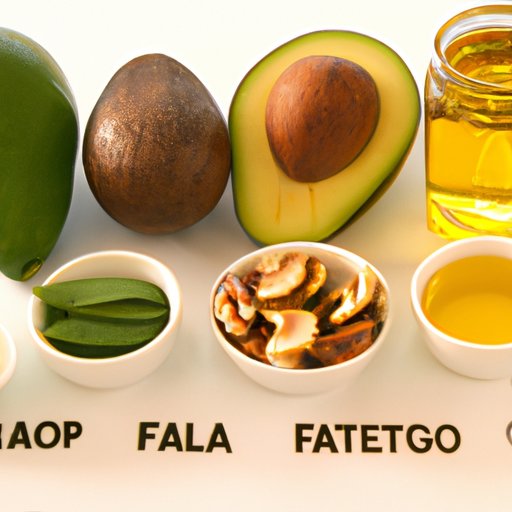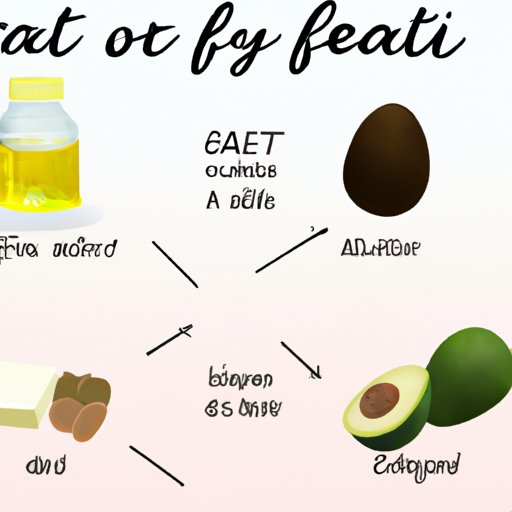Introduction
When it comes to eating a healthy diet, many people focus on avoiding unhealthy fats. However, it’s important to also make sure to include healthy fats in your diet. Healthy fats provide essential nutrients, help absorb vitamins, and can even reduce your risk of certain diseases. But what exactly are healthy fats?
Healthy fats are unsaturated fats that are beneficial to your health. Unsaturated fats are liquid at room temperature and come from both plant and animal sources. They are broken down into two categories: polyunsaturated and monounsaturated fats. Both types of unsaturated fats have been linked to numerous health benefits, including improved heart health, better cognitive function, and reduced inflammation.
Identifying Healthy Fats: A Comprehensive Guide
Uncovering the truth about dietary fats can be confusing, as there are so many different types of fats. It’s important to understand the role of each type of fat in order to make informed decisions when choosing which fats to include in your diet. To help you determine which fats are healthy, here is an overview of “good” and “bad” fats.
The “good” fats include polyunsaturated fats, monounsaturated fats, and omega-3 fatty acids. Polyunsaturated fats are found in nuts, seeds, and vegetable oils. They are known for their anti-inflammatory properties and have been linked to a lower risk of heart disease. Monounsaturated fats are also found in plant sources such as avocados, olives, and nuts. They have been shown to help reduce bad cholesterol levels and improve overall heart health. Omega-3 fatty acids are found in fish, flaxseed, and walnuts. These fats are essential for brain development and have been linked to a reduced risk of depression, dementia, and Alzheimer’s disease.
On the other hand, “bad” fats include saturated and trans fats. These fats are solid at room temperature and are found in processed foods such as margarine, fried foods, and baked goods. They have been linked to an increased risk of heart disease, stroke, and obesity. It’s best to limit or avoid these types of fats whenever possible.

Common Sources of Healthy Fats
Now that you know the difference between healthy and unhealthy fats, let’s take a look at some of the most common sources of healthy fats.
Common Sources of Omega-3 Fatty Acids
Omega-3 fatty acids are one of the most important types of healthy fats. They are essential for proper brain development and can reduce inflammation. The best sources of omega-3 fatty acids are fatty fish such as salmon, mackerel, and herring. Other good sources include flaxseed, walnuts, chia seeds, and hemp seeds.
Common Sources of Monounsaturated Fats
Monounsaturated fats are found in a variety of plant sources, including olive oil, avocados, olives, nuts, and seeds. These fats have been linked to a reduced risk of heart disease and improved cholesterol levels.
Common Sources of Polyunsaturated Fats
Polyunsaturated fats are found in a variety of plant sources, such as vegetable oils, nuts, seeds, and fish. These fats have been linked to a reduced risk of heart disease, stroke, and diabetes. Some of the best sources of polyunsaturated fats include sunflower oil, corn oil, soybean oil, walnuts, and salmon.

How to Incorporate Healthy Fats into Your Diet
Including healthy fats in your diet is important for optimal health. Here are some tips for increasing healthy fats in your diet.
Tips for Increasing Healthy Fats in Your Diet
The first step in incorporating healthy fats into your diet is to replace unhealthy fats with healthier alternatives. For example, instead of using butter or margarine, try using olive oil or avocado oil. You can also use nuts and seeds as a topping for salads and yogurt, or add them to smoothies. Additionally, try to eat more fatty fish such as salmon, mackerel, and herring, which are all excellent sources of omega-3 fatty acids.
Making Healthy Choices When Eating Out
Eating out can be a challenge when trying to incorporate healthy fats into your diet. When dining out, try to choose dishes that are cooked with healthy fats such as olive oil or avocado oil. You can also ask for dressings and sauces on the side so you can control how much you use. Additionally, opt for grilled or steamed dishes instead of fried ones.
How to Balance the Amount of Healthy Fats in Your Diet
It’s important to make sure you are getting a balance of all the different types of healthy fats. Aim to include a variety of sources in your diet, such as nuts, seeds, fatty fish, and vegetable oils. Additionally, try to keep your intake of unhealthy fats to a minimum by avoiding processed foods, fried foods, and foods high in saturated fat.
Conclusion
Healthy fats are an important part of a balanced diet. They provide essential nutrients, help absorb vitamins, and can even reduce your risk of certain diseases. There are three main types of healthy fats: omega-3 fatty acids, monounsaturated fats, and polyunsaturated fats. Common sources of these healthy fats include fatty fish, nuts, seeds, and vegetable oils. To incorporate these healthy fats into your diet, try replacing unhealthy fats with healthier alternatives, making healthy choices when eating out, and balancing the amount of healthy fats in your diet. By following these tips, you can ensure that you are getting enough of these essential fats in your diet.
(Note: Is this article not meeting your expectations? Do you have knowledge or insights to share? Unlock new opportunities and expand your reach by joining our authors team. Click Registration to join us and share your expertise with our readers.)
